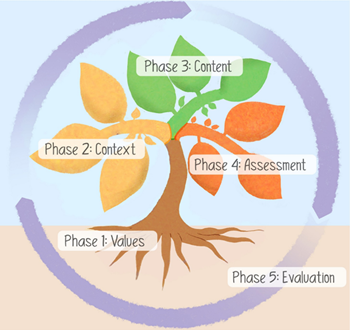25 July 2023
Root to shoots: A holistic route to designing high quality inclusive learning environments

Author
Virna Rossi
Associate Professor and PGCert Course Leader, Ravensbourne University London
Virna Rossi is an Associate Professor and PGCert Course Leader at Ravensbourne University London. Her research focuses on the challenges of implementing more inclusive learning design and the use of threshold concepts in learning design. She is the author of an innovative book: Rossi, V (2023) Inclusive Learning Design in Higher Education. London: Routledge and of its companion website.
Virna was a panel member at QAA Membership’s Quality Insights Conference in 2023 discussing approaches to creating successful academic communities.
Activate your inner dialogue, and reflect upon:
- What values guide your approach to higher education?
- Which values do you associate closely with inclusivity?
- What is the relationship of quality enhancement with designing inclusive practice?
- Do you believe that the learning experiences and environments you create align with those values?
The prompts above highlight the increased interest and recognition around the place of values in education: values matter in learning, not just skills and knowledge. We can see evidence of this in the revised Subject Benchmark Statements published by QAA where values now permeate the Statements whereas previous versions tended to focus mostly on knowledge and skills.
For example, in Chemistry there is reference to involvement with global challenges and professionalism. So as educators we are challenged to instil professional and ethical values in our students, not only knowledge and skills. This highlights that quality assurance and enhancement act as a compass guiding inclusive learning design, ensuring that student learning is equitable and empowering for them. Values are at the root (literally) of my own approach to designing learning environments and experiences called the ‘roots to shoots’ inclusive learning design approach.
In my approach, the roots represent the values which inform inclusive educational practices. The roots to shoots approach is an invitation to tackle learning design from the perspective of inclusivity and intentionally from the start and in all aspects of students’ experience of higher education.
As inclusivity has become a contested buzz word within the sector, to clarify its meaning I offer a definition with a breakdown of what it looks like in practice.
My working definition of inclusive learning design:
Inclusive learning design is design that considers the full range of human diversity with its complexity. It is designing learning environments, experiences, activities, tasks, assessment and feedback with students’ voice and choice at its heart, so that students can grow academically, culturally and socially.
To better illustrate the meaning of inclusive learning design, I use the word ‘inclusive’ as an acronym through which I provide nine values (the nine roots) which are key facets of inclusivity pointing to how an inclusive approach would look in practice:
I. Intentionally equitable
N. Nurturing
C. Co-created
L. Liberating
U. User-friendly
S. Socially responsible
I. Integrative
V. Values-based
E. Ecological
These are not all neatly separated values, they overlap considerably. Each value contributes to my approach to more inclusive learning design. The ‘V’ for the values-based root is a ‘meta-root’: it is about the importance of being driven by appropriate inclusivity values which we should clarify and articulate from the outset. QAA Members will find interesting parallels between my roots-to-shoots approach and QAA guidance on Creating Inclusive Subject Learning Communities and the related Questions for Reflection, towards creating an inclusive approach to teaching, learning and assessment design thinking and practice.
Noticing, articulating and reflecting on our values as educators can be a transformative process (Anaissie et al, 2020). Without a focus on curriculum design values, ‘we will merely attempt to replicate that which is familiar, whether it works or not’ (Kleiman 2009).
The values at the root of the symbolic learning design tree are the first phase in my five-stage approach. In fact, the concept of ‘roots to shoots’ that underpins the approach is illustrated in a circular path around a symbolic tree with roots and branches to represent five phases or stages of learning design, as shown in the image below:
- Values
- Context
- Content
- Assessment
- Evaluation.

The approach invites teachers to (collaboratively) consider each of the five dimensions in turn, to form an overall big picture of the learning experience they are designing. Each phase corresponds to a section in the book where it is discussed and exemplified through many international case studies.
Phase 1: Values - the Roots
Main question: Which values inform your (inclusive) design and practices?
Mine are listed above, through the I.N.C.L.U.S.I.V.E. acronym.
Phase 2 – Learning Context
Main question: Which contextual factors inform your (inclusive) learning design and practices?
By understanding the context, teachers can create supportive systems and engage students effectively.
Phase 3 - Learning Content
Main questions: How can you provide input and practice in a more inclusive way? What are the challenges?
The central branch of the tree represents the learning content, which encompasses the presentation and engagement with key concepts and practices in the discipline using universal design for learning (UDL) principles.
Phase 4 - Learning Assessment
Main questions: How can you design more inclusive assessment outputs and feedback? What are the challenges?
By creating inclusive assessment strategies, educators can ensure that all learners have equitable opportunities to showcase their knowledge and skills.
Phase 5 - Learning Evaluation
Main questions: How will you evaluate your efforts to design more inclusive learning? What are the challenges?
The concepts of evaluation, iteration and refinement serve as guiding principles for enhancing inclusive learning environments and practices.
Conclusion
The journey from roots to shoots starts by (1) embracing inclusive values; it continues by (2) understanding and engaging with the learning context, (3) designing inclusive content, (4) implementing inclusive assessments, and (5) continuously evaluating and refining design and practices.
This comprehensive approach enables colleagues to embrace inclusivity, where learning and teaching experiences are enriched because educators have the tools to embark on a journey leading to improved learning outcomes, increased student satisfaction, and ultimately, a higher quality of education for all learners.
References
Anaissie, T, Cary, V, Clifford, D, Malarkey, T and Wise, S (2020). Liberatory design: your toolkit to design for equity, version 1.0 [card deck]. Stanford k12 lab network. Available at: https://dschool.stanford.edu/s/Liberatory-Design-Cards.pdf
Kleiman, P (2009) Design for learning: a guide to the principles of good curriculum design. [ebook] Palatine (HEA). Available at: http://cielassociates.co.uk/wp- content/uploads/2014/08/KLEIMAN2009DesignforLearning.pdf
Rossi, V (2023) Inclusive Learning Design in Higher Education - A Practical Guide to Creating Equitable Learning Experiences. London: Routledge
Further resources
To find out more about A Practical Guide to Creating Equitable Learning Experiences, Preview the book. Check the companion website for case studies linked to the five dimensions discussed above, including mini videos by the contributors.
The website also has a:
- Discussion of key terms such as ‘learning design’ and ‘inclusivity’ and why they matter in higher education now.
- Useful checklist to be used as an aide-mémoire for those (re-)designing courses or modules.
- Glossary of teaching and learning terms (used in the book) to develop shared meaning.
QAA Membership resources
- Creating Inclusive Subject Learning Communities, along with its accompanying set of Questions for Reflection, is a tool for academic and professional teams seeking to cultivate inclusive pedagogical approaches.
- Outcomes-based Approaches to Learning, Teaching and Assessment provides a collection of materials, tools and case studies that facilitate the development of inclusive and authentic learning environments.
- Collaborative Enhancement Projects offer a diverse range of ideas and practical resources to support educators in teaching, learning and assessment. Several have an inclusivity dimension.
